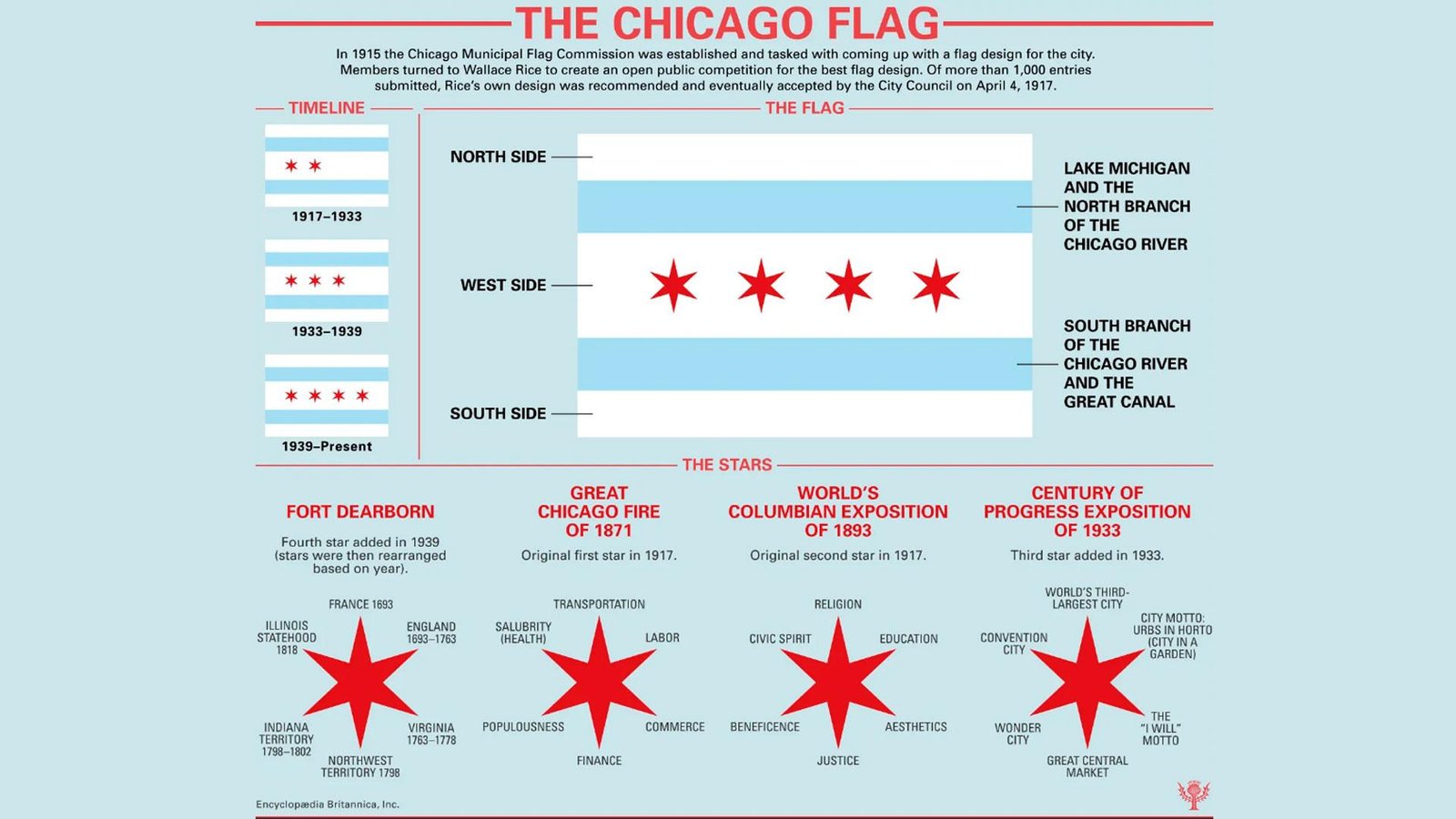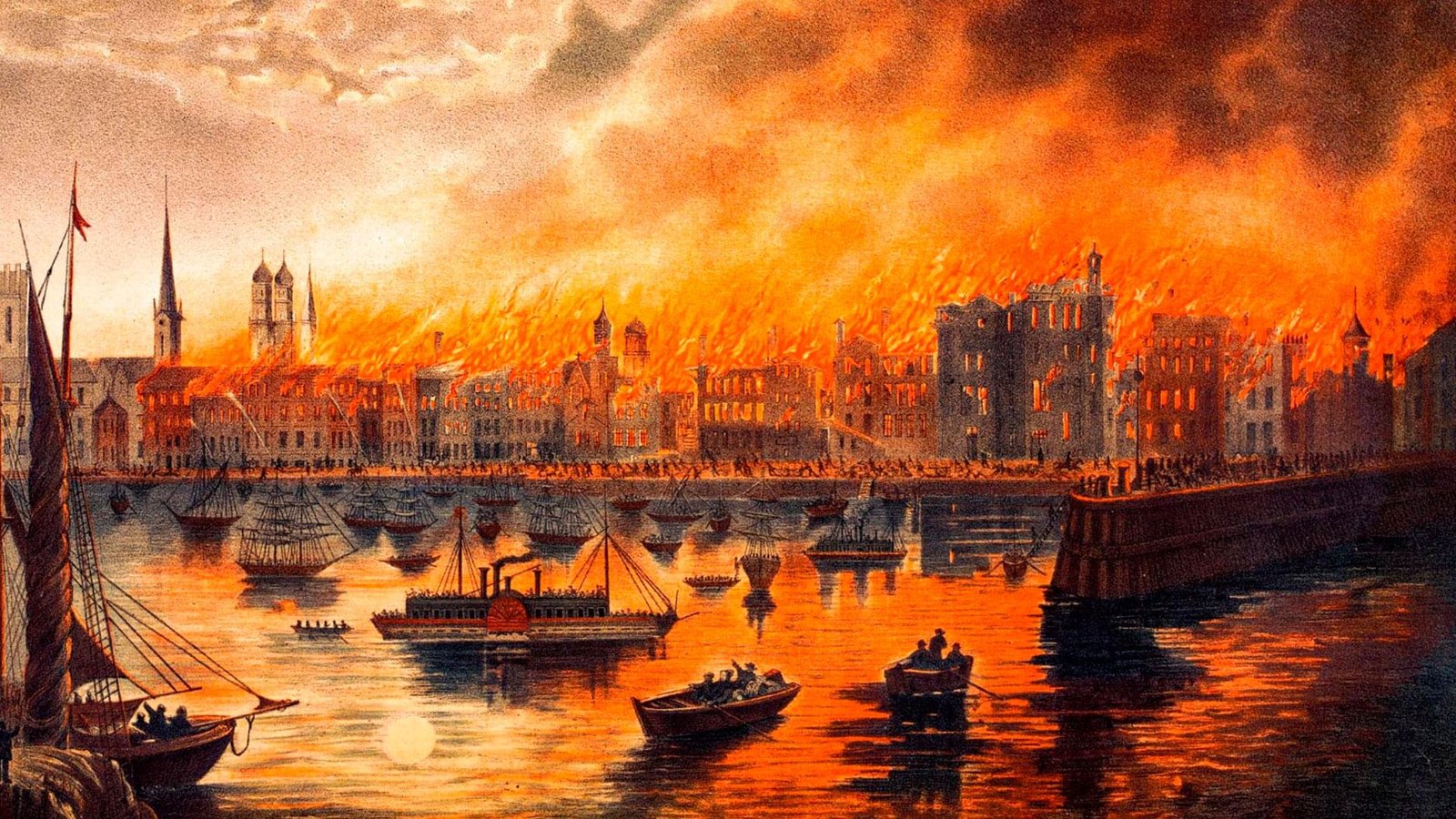Who Designed the Chicago Flag?
In a 2004 survey by the North American Vexillological Association, the Chicago flag was rated as the second-best among 150 city flags in the U.S., with a high score of 9.03 out of 10. The only flag rated higher was Washington, D.C.’s.
In this article, we’ll explore the Chicago Flag’s symbolism and history. Learn about the elements that make this flag so special and how it represents the city’s rich culture and history. Discover what makes this flag a key part of Chicago’s identity!

Table of Contents
The History of the Chicago Flag
In 1915, Chicago Mayor Carter Harrison, Jr. decided it was time for the city to have an official flag, like many other American cities. Previously, the 1893 World’s Fair had used a red “Y” banner to represent the city’s colors. The committee received over 1,000 designs before choosing Wallace Rice’s design. Rice was a flag expert from the Art Institute of Chicago.
The Chicago Flag features two shades of blue and four red stars. Each star represents significant events in the city’s history, symbolizing both its past and future. The flag is now known for its beauty and strong symbolism among municipal flags in the U.S.
Symbolism of the Chicago Flag

Wallace Rice’s design is simple but meaningful, showing Chicago’s rich history. The flag has two light blue horizontal stripes on a white background, making three alternating sections. The central, wider white stripe has four red six-pointed stars. The blue stripes and white sections represent the city’s geography.
Rice chose six-pointed stars to set them apart from the more common five-pointed stars seen on national flags. The points, angled at 30 degrees, also distinguish them from the Star of David. He positioned the stars close to the hoist (the flagpole side), anticipating that more stars might be added in the future, which happened in the 1930s when two additional stars were included.
Despite campaigns to add a fifth star, the flag’s design has remained unchanged since 1939.
The Meaning Behind the Bars
The Chicago flag features three white sections representing, from top to bottom, the North, West, and South sides of the city. The top blue stripe stands for Lake Michigan and the North Branch of the Chicago River. The bottom blue stripe represents the South Branch of the river and the “Great Canal,” which runs through the Chicago Portage.
The shade of blue used in the stripes is commonly referred to as light blue or sky blue. In a 1917 speech by Wallace Rice, the flag’s designer, he described this color as “the color of water.”
The Meaning Behind the Stars
The stars on Chicago’s flag, from the hoist outwards, represent:
- Added in 1939: Commemorates Fort Dearborn. Its six points represent the political entities and flags that ruled the Chicago region: France (1693), Great Britain (1763), Virginia (1778), Northwest Territory (1789), Indiana Territory (1802), and Illinois (territory in 1809, state since 1818).
- Original to 1917: Represents the Great Chicago Fire of 1871. Its six points symbolize the city’s virtues: religion, education, aesthetics, justice, beneficence, and civic pride.
- Original to 1917: Symbolizes the World’s Columbian Exposition of 1893. The six points represent the city’s pillars: transportation, labor, commerce, finance, populousness, and health.
- Added in 1933: Represents the Century of Progress Exposition (1933-34). The points of the star highlight Chicago’s status as the second-largest U.S. city at the time, its Latin motto Urbs in horto (“City in a Garden”), the “I Will” motto, the Great Central Marketplace, Wonder City, and Convention City.
Fort Dearborn

Fort Dearborn was a U.S. military post built in 1803 along the Chicago River, in Chicago, Illinois. It was named after Henry Dearborn, U.S. Secretary of War, and was destroyed during the War of 1812. A new fort was built in 1816 in Fort Dearborn foundation and remained active until 1837.
Parts of the fort were lost due to the expansion of the Chicago River in 1855 and further damage from a fire in 1857. The last remains were destroyed in the Great Chicago Fire of 1871. Today, the site is a designated Chicago Landmark, located at the southern end of the DuSable Michigan Avenue Bridge.
The Great Chicago Fire

The Great Chicago Fire, which burned from October 8 to 10, 1871, caused around 300 deaths, destroyed about 3.3 square miles of the city, and left over 100,000 people homeless. The blaze consumed more than 17,000 buildings. It started in a neighborhood southwest of downtown Chicago. Hot, dry, and windy weather, along with the city’s wooden buildings, made the fire spread quickly. It crossed the south branch of the Chicago River, destroyed much of downtown, and then jumped over the main river, burning the Near North Side.
After the fire, help came from many places, aiding Chicago’s recovery. The city set stricter building codes to avoid future fires and rebuilt quickly with stronger materials. A major donation from the UK helped establish the Chicago Public Library
World’s Columbian Exposition of 1893

The World’s Columbian Exposition, or the Chicago World’s Fair, was held from May 5 to October 31, 1893. It celebrated the 400th anniversary of Christopher Columbus’s arrival in the Americas. The main feature of the fair, held in Jackson Park, was a grand water display representing Columbus’s ocean voyage. Chicago was chosen to host the event over cities like New York, Washington, D.C., and St. Louis. The exposition left a lasting mark on American architecture, the arts, and industry, and it helped build Chicago’s strong reputation.
The Century of Progress Exposition of 1933-34

The Chicago World’s Fair, was held in 1933-34 to celebrate the city’s 100th birthday. Recognized by the Bureau International des Expositions, the fair showcased the latest in technology with the theme “Science Finds, Industry Applies, Man Conforms.” A highlight of the fair was the Sky Ride—a bridge that allowed visitors to travel across the grounds, demonstrating the event’s focus on innovation and modernity.
How the Chicago Flag Became a Cultural Icon
Chicago’s flag is a prominent part of city life. It’s a common sight on porches, T-shirts, and even as tattoos. There’s a whole website dedicated to these tattoos, and you’ll spot the flag on all sorts of items—hats, bags, guitars, coffee mugs, and more. Sometimes, the flag’s design is creatively altered into shapes like shamrocks, hearts, or pizza slices, and its stars are replaced with sports logos.
The flag’s deep connection to the city really grew in the 1990s when many young people moved to Chicago. Michael, a kickball player featured on the tattoo website, shared why he chose to get the flag tattooed: “After living in Chicago for a few years, the city really became a part of me, so I felt it was a good way to show that.”
Conclusion
The Chicago flag was designed by writer and historian Wallace Rice in 1917 after a city competition. His design included two blue stripes symbolizing the North and South branches of the Chicago River. The original two red stars, each with six points, represent significant events: Fort Dearborn and the Great Chicago Fire. Later, two more stars were added to honor the World’s Columbian Exposition and the Century of Progress Exposition. The flag is now considered one of the best city flags in the U.S.
Nova Chicago is an Agency that helps businesses and personal brands attract high-paying clients through design and strategy.
Quick Links
Get In Touch
- Email: Contact@novachicago.design
- Phone: +55 (84) 99854 3058
- Hours: Mon-Fri 9:00AM - 5:00PM
